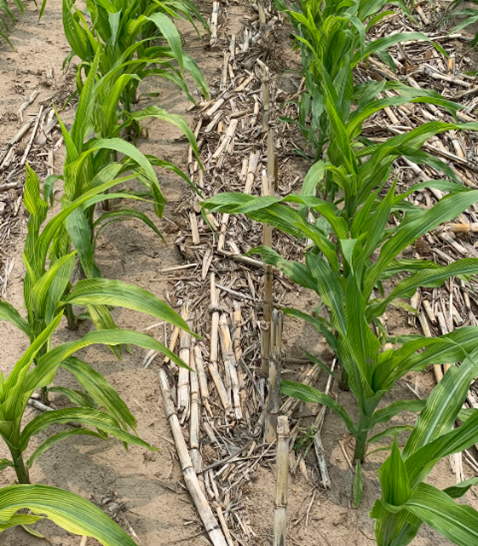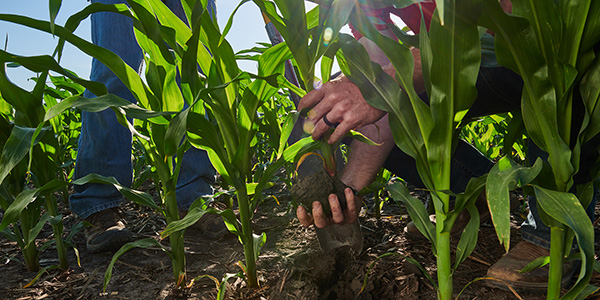AGRONOMICSUPPORT
YOU CAN TAKETO THE FIELD
Data from High Soil pH Trials Helps Farmers Select Seed
LG Seeds Agronomist Matt Teply has spent his entire career on the High Plains, helping farmers determine which corn hybrids and soybean varieties pair well with the dry weather and the alkaline soils of the region. He has seen firsthand the troubles high soil pH can cause.
Because this is such a critical issue, Teply says the following three questions always come up when western growers discuss products:
- How much water do you have?
- Do you have to worry about any high pH spots or high calcium, high magnesium soils?
- What are your yield goals and plant population plans?
Teply explains there’s a distinct difference in hybrids and varieties that can handle the alkaline-prone higher calcium, higher magnesium (calcareous) soils and those that can’t. And there has been an influx of germplasm and new products in recent years.
That influx motivated him to conduct trials distinguishing which LG Seeds products can best handle calcareous soils, so he can better guide farmers. “Many products can handle higher pH soil. Whether or not they can handle the ‘badger dirt’ of the white clay hills is the bigger question,” Teply explains.
The trouble with high pH soils

The porous, chalk-like calcareous soils on which Teply is running trials are typically found in semi-arid to arid regions of the country like the western High Plains. He details that some of his biggest problem areas include western Nebraska, eastern Colorado, and all the way down to the Panhandle of Texas, though he says incidences dissipate as one heads south.
“Other areas of the U.S. may have high pH soils, but as you head eastward and rainfall increases, the tendency is for high pH soils to be higher in sodium,” Teply explains. Those regional differences in soil type drive home why it’s important to work with an agronomist who knows your region.
Teply generalizes soil pH at or above 7.2 as the point when the availability of nutrients diminishes. “The macronutrient most affected by higher pH soils is phosphorus,” he says.
“When phosphorus is tied up in the soil, it impacts many plant growth processes from healthy roots to the processes within the actual corn or soybean plant critical to daily operation.”
Phosphorus (P), next to nitrogen, is often the most limiting nutrient for crop production, according to USDA’s Natural Resources Conservation Service (NRCS). “Adequate P levels encourage vigorous root and shoot growth, promote early maturity, increase water use efficiency and grain yield. Thus, P deficiency stunts vegetative growth and grain yield,” NRCS details.
Other nutrients that can get tied up as soil pH rises are iron, zinc and boron. Nutrient tie-up leads to stunted plant growth and yellowing associated with iron deficiency chlorosis (IDC) in patchy areas across a field, which can ultimately drag down yields.
Spring weather comes into play
Spring weather can make a major difference when it comes to withstanding high pH environments of the West. “If we have a consistent early growing season and plants root down and develop at a normal pace, the issues we see from these high calcium, high magnesium soils don’t seem to be as bad,” Teply says.
However, Teply cautions, “If we don’t get beans off to a good start, they have a hard time in these soil types trying to catch back up. The difference from year-to-year can be dramatic.”
The 2022 growing season was particularly challenging. It featured wild air and soil temperature swings in the spring and historic drought across much of the region, impacting both corn and soybeans. There has been a lot more IDC, according to Teply, who adds, “Conditions are so bad in some areas that some corn was already being chopped for silage in late July.”
Steps you can take for alkaline soils
“The first defense is hybrid selection, because we know from testing that some hybrids are going to handle high soil pH better than others,” Teply says.
“A solid starter fertilizer program and use of fulvic acid can help promote early root growth and help the corn crop get started,” Teply continues. There are also different formulations of phosphates that he says can help with the availability of phosphorus. “And then you hope for a really good spring,” he adds.
The most important thing, according to Teply, is to talk with your local LG Seeds agronomist. “We have a good handle on what works in higher pH situations and can help you place the right product on the right acre,” he says. “If you’re not doing that, you’re not giving yourself a chance from the get-go.”





